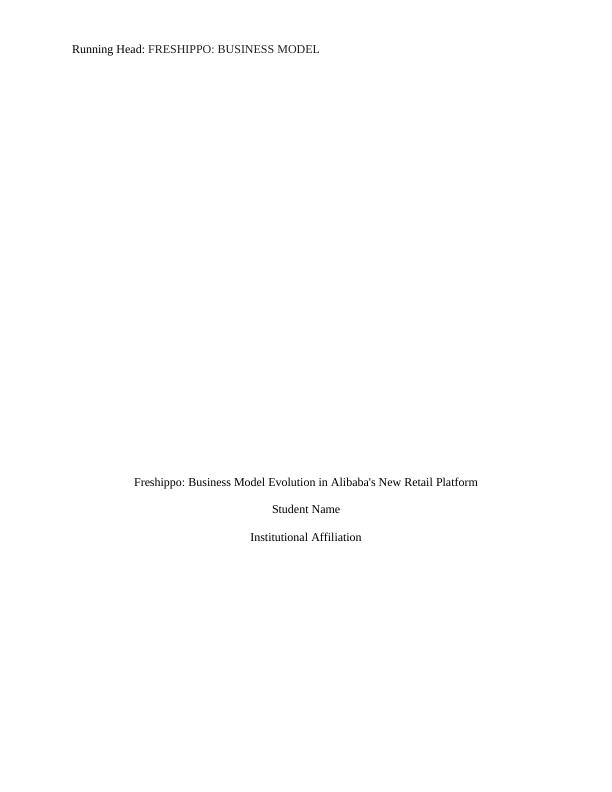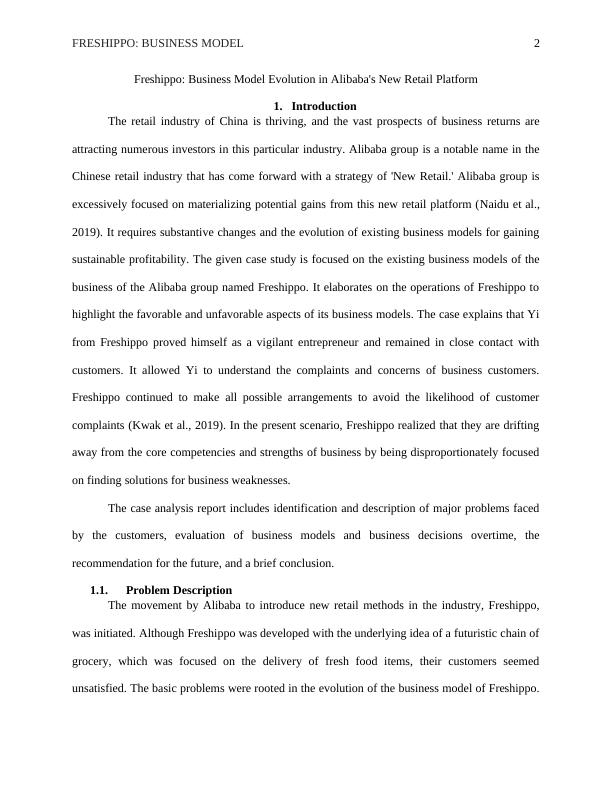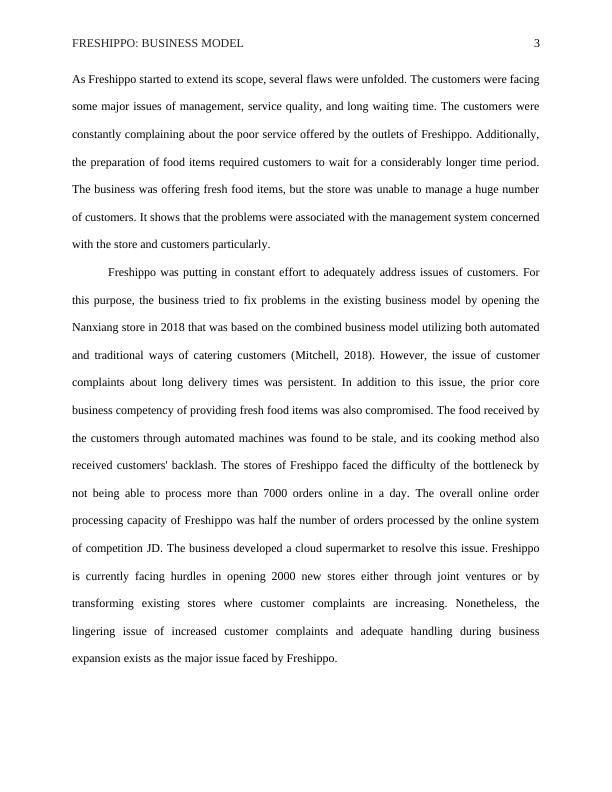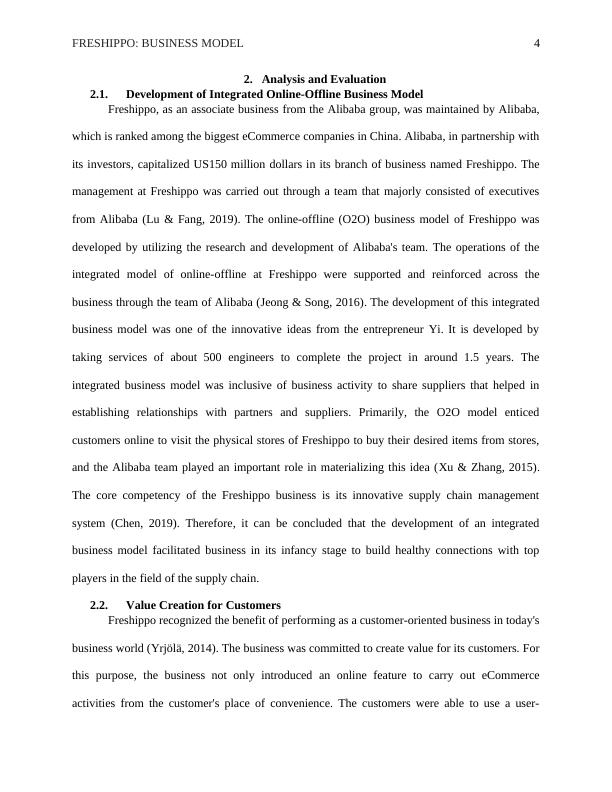Freshippo : Business Model Case Study 2022
Added on 2022-09-22
11 Pages3280 Words22 Views
Running Head: FRESHIPPO: BUSINESS MODEL
Freshippo: Business Model Evolution in Alibaba's New Retail Platform
Student Name
Institutional Affiliation
Freshippo: Business Model Evolution in Alibaba's New Retail Platform
Student Name
Institutional Affiliation

FRESHIPPO: BUSINESS MODEL 2
Freshippo: Business Model Evolution in Alibaba's New Retail Platform
1. Introduction
The retail industry of China is thriving, and the vast prospects of business returns are
attracting numerous investors in this particular industry. Alibaba group is a notable name in the
Chinese retail industry that has come forward with a strategy of 'New Retail.' Alibaba group is
excessively focused on materializing potential gains from this new retail platform (Naidu et al.,
2019). It requires substantive changes and the evolution of existing business models for gaining
sustainable profitability. The given case study is focused on the existing business models of the
business of the Alibaba group named Freshippo. It elaborates on the operations of Freshippo to
highlight the favorable and unfavorable aspects of its business models. The case explains that Yi
from Freshippo proved himself as a vigilant entrepreneur and remained in close contact with
customers. It allowed Yi to understand the complaints and concerns of business customers.
Freshippo continued to make all possible arrangements to avoid the likelihood of customer
complaints (Kwak et al., 2019). In the present scenario, Freshippo realized that they are drifting
away from the core competencies and strengths of business by being disproportionately focused
on finding solutions for business weaknesses.
The case analysis report includes identification and description of major problems faced
by the customers, evaluation of business models and business decisions overtime, the
recommendation for the future, and a brief conclusion.
1.1. Problem Description
The movement by Alibaba to introduce new retail methods in the industry, Freshippo,
was initiated. Although Freshippo was developed with the underlying idea of a futuristic chain of
grocery, which was focused on the delivery of fresh food items, their customers seemed
unsatisfied. The basic problems were rooted in the evolution of the business model of Freshippo.
Freshippo: Business Model Evolution in Alibaba's New Retail Platform
1. Introduction
The retail industry of China is thriving, and the vast prospects of business returns are
attracting numerous investors in this particular industry. Alibaba group is a notable name in the
Chinese retail industry that has come forward with a strategy of 'New Retail.' Alibaba group is
excessively focused on materializing potential gains from this new retail platform (Naidu et al.,
2019). It requires substantive changes and the evolution of existing business models for gaining
sustainable profitability. The given case study is focused on the existing business models of the
business of the Alibaba group named Freshippo. It elaborates on the operations of Freshippo to
highlight the favorable and unfavorable aspects of its business models. The case explains that Yi
from Freshippo proved himself as a vigilant entrepreneur and remained in close contact with
customers. It allowed Yi to understand the complaints and concerns of business customers.
Freshippo continued to make all possible arrangements to avoid the likelihood of customer
complaints (Kwak et al., 2019). In the present scenario, Freshippo realized that they are drifting
away from the core competencies and strengths of business by being disproportionately focused
on finding solutions for business weaknesses.
The case analysis report includes identification and description of major problems faced
by the customers, evaluation of business models and business decisions overtime, the
recommendation for the future, and a brief conclusion.
1.1. Problem Description
The movement by Alibaba to introduce new retail methods in the industry, Freshippo,
was initiated. Although Freshippo was developed with the underlying idea of a futuristic chain of
grocery, which was focused on the delivery of fresh food items, their customers seemed
unsatisfied. The basic problems were rooted in the evolution of the business model of Freshippo.

FRESHIPPO: BUSINESS MODEL 3
As Freshippo started to extend its scope, several flaws were unfolded. The customers were facing
some major issues of management, service quality, and long waiting time. The customers were
constantly complaining about the poor service offered by the outlets of Freshippo. Additionally,
the preparation of food items required customers to wait for a considerably longer time period.
The business was offering fresh food items, but the store was unable to manage a huge number
of customers. It shows that the problems were associated with the management system concerned
with the store and customers particularly.
Freshippo was putting in constant effort to adequately address issues of customers. For
this purpose, the business tried to fix problems in the existing business model by opening the
Nanxiang store in 2018 that was based on the combined business model utilizing both automated
and traditional ways of catering customers (Mitchell, 2018). However, the issue of customer
complaints about long delivery times was persistent. In addition to this issue, the prior core
business competency of providing fresh food items was also compromised. The food received by
the customers through automated machines was found to be stale, and its cooking method also
received customers' backlash. The stores of Freshippo faced the difficulty of the bottleneck by
not being able to process more than 7000 orders online in a day. The overall online order
processing capacity of Freshippo was half the number of orders processed by the online system
of competition JD. The business developed a cloud supermarket to resolve this issue. Freshippo
is currently facing hurdles in opening 2000 new stores either through joint ventures or by
transforming existing stores where customer complaints are increasing. Nonetheless, the
lingering issue of increased customer complaints and adequate handling during business
expansion exists as the major issue faced by Freshippo.
As Freshippo started to extend its scope, several flaws were unfolded. The customers were facing
some major issues of management, service quality, and long waiting time. The customers were
constantly complaining about the poor service offered by the outlets of Freshippo. Additionally,
the preparation of food items required customers to wait for a considerably longer time period.
The business was offering fresh food items, but the store was unable to manage a huge number
of customers. It shows that the problems were associated with the management system concerned
with the store and customers particularly.
Freshippo was putting in constant effort to adequately address issues of customers. For
this purpose, the business tried to fix problems in the existing business model by opening the
Nanxiang store in 2018 that was based on the combined business model utilizing both automated
and traditional ways of catering customers (Mitchell, 2018). However, the issue of customer
complaints about long delivery times was persistent. In addition to this issue, the prior core
business competency of providing fresh food items was also compromised. The food received by
the customers through automated machines was found to be stale, and its cooking method also
received customers' backlash. The stores of Freshippo faced the difficulty of the bottleneck by
not being able to process more than 7000 orders online in a day. The overall online order
processing capacity of Freshippo was half the number of orders processed by the online system
of competition JD. The business developed a cloud supermarket to resolve this issue. Freshippo
is currently facing hurdles in opening 2000 new stores either through joint ventures or by
transforming existing stores where customer complaints are increasing. Nonetheless, the
lingering issue of increased customer complaints and adequate handling during business
expansion exists as the major issue faced by Freshippo.

FRESHIPPO: BUSINESS MODEL 4
2. Analysis and Evaluation
2.1. Development of Integrated Online-Offline Business Model
Freshippo, as an associate business from the Alibaba group, was maintained by Alibaba,
which is ranked among the biggest eCommerce companies in China. Alibaba, in partnership with
its investors, capitalized US150 million dollars in its branch of business named Freshippo. The
management at Freshippo was carried out through a team that majorly consisted of executives
from Alibaba (Lu & Fang, 2019). The online-offline (O2O) business model of Freshippo was
developed by utilizing the research and development of Alibaba's team. The operations of the
integrated model of online-offline at Freshippo were supported and reinforced across the
business through the team of Alibaba (Jeong & Song, 2016). The development of this integrated
business model was one of the innovative ideas from the entrepreneur Yi. It is developed by
taking services of about 500 engineers to complete the project in around 1.5 years. The
integrated business model was inclusive of business activity to share suppliers that helped in
establishing relationships with partners and suppliers. Primarily, the O2O model enticed
customers online to visit the physical stores of Freshippo to buy their desired items from stores,
and the Alibaba team played an important role in materializing this idea (Xu & Zhang, 2015).
The core competency of the Freshippo business is its innovative supply chain management
system (Chen, 2019). Therefore, it can be concluded that the development of an integrated
business model facilitated business in its infancy stage to build healthy connections with top
players in the field of the supply chain.
2.2. Value Creation for Customers
Freshippo recognized the benefit of performing as a customer-oriented business in today's
business world (Yrjölä, 2014). The business was committed to create value for its customers. For
this purpose, the business not only introduced an online feature to carry out eCommerce
activities from the customer's place of convenience. The customers were able to use a user-
2. Analysis and Evaluation
2.1. Development of Integrated Online-Offline Business Model
Freshippo, as an associate business from the Alibaba group, was maintained by Alibaba,
which is ranked among the biggest eCommerce companies in China. Alibaba, in partnership with
its investors, capitalized US150 million dollars in its branch of business named Freshippo. The
management at Freshippo was carried out through a team that majorly consisted of executives
from Alibaba (Lu & Fang, 2019). The online-offline (O2O) business model of Freshippo was
developed by utilizing the research and development of Alibaba's team. The operations of the
integrated model of online-offline at Freshippo were supported and reinforced across the
business through the team of Alibaba (Jeong & Song, 2016). The development of this integrated
business model was one of the innovative ideas from the entrepreneur Yi. It is developed by
taking services of about 500 engineers to complete the project in around 1.5 years. The
integrated business model was inclusive of business activity to share suppliers that helped in
establishing relationships with partners and suppliers. Primarily, the O2O model enticed
customers online to visit the physical stores of Freshippo to buy their desired items from stores,
and the Alibaba team played an important role in materializing this idea (Xu & Zhang, 2015).
The core competency of the Freshippo business is its innovative supply chain management
system (Chen, 2019). Therefore, it can be concluded that the development of an integrated
business model facilitated business in its infancy stage to build healthy connections with top
players in the field of the supply chain.
2.2. Value Creation for Customers
Freshippo recognized the benefit of performing as a customer-oriented business in today's
business world (Yrjölä, 2014). The business was committed to create value for its customers. For
this purpose, the business not only introduced an online feature to carry out eCommerce
activities from the customer's place of convenience. The customers were able to use a user-

End of preview
Want to access all the pages? Upload your documents or become a member.
Related Documents
Freshippo : Business Model Evolution PowerPoint Presentation 2022lg...
|11
|639
|23
Entrepreneurship PowerPoint Presentation 2022lg...
|12
|525
|23
Assignment On The Entrepreneurship.lg...
|15
|3370
|17
Case Study on Managerial Issues at Freshippo Companylg...
|5
|802
|28
Business Analysis Reportlg...
|18
|3364
|70
Service Marketing: A Case Study on David Jones' Service Blueprint and Qualitylg...
|12
|814
|335